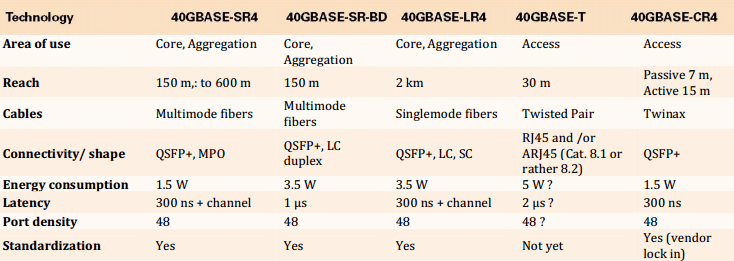– Shajan George, Technical Director at R&M, says:
40 gigabits per second – 40 Gbit. That is the new benchmark for data centers. If you want to ensure top performance in the cloud era, you are going to have to make sure your networks can cope with this transmission speed. There are five possible different technologies.
An overview— When enterprises are planning 40-gigabit projects in data centers and thinking about whether investing is worth it, there are a number of criteria to be taken into consideration. First of all enterprises should think about the application area: If they are planning for the Core and Aggregation Layer, you are looking at links of at least fifteen meters. In larger facilities, distances of 100 meters and more may have to be covered.
In the future, 40 gigabits will also be used in the Access Layer which mostly involves shorter distances of up to 30 meters. Here consumers are looking for suitable solutions for Top-of-Rack (TOR) or End-of-Row (EOR) architectures. The suitable technology and reach have to be selected to correspond to the particular application area. But whichever way organization look at it, there is no one solution that can cover all requirements at a low price at the same time.
Technical planning criteria— There are other technical criteria that play a role in planning: Attenuation, latency, energy consumption, heat generation, connector shape, cable diameters and port density should be compared. The current stage of standardization and thus the effectiveness for the future of the selected solution are important.
Ultimately, the degree of modularity, scalability, reliability of the investment, ease of use and value for money should be looked into in depth. Various manufacturers set great store by proprietary components. Planners and operators should weigh up whether a solution is compatible, interoperable and independent in use.
The more complex networks in data centers become the more and more crucial it will be to use systems for monitoring and Automatic Infrastructure Management (AIM). Are the distribution and cabling systems selected ready for that?
Five 40GBASE-x technologies— Essentially, there are currently five different 40GBASE-x technologies available. They all have their advantages and disadvantages. The table lists fundamental distinguishing features.
If organizations consider 40GBASE-CR4 with Twinax cabling, availability and technology maturity will play a role. In the long-distance sector, your eyes will naturally be drawn to the comparatively cost-efficient multimode solution, 40-GBASE-SR4.
40GBASE-T is still in the standardization phase. This means that we can currently only guess at energy consumption and the resulting port density and latency. But basically there is a wide range of technology available. The solutions have different strengths, weaknesses and levels of maturity. Each technology has a right to exist. The right technology mix should be analyzed and determined for each specific case.






